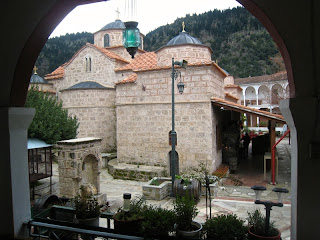View Larger Map
On Saturday, the last weekend before Clean Monday and the beginning of Great Lent, our parish took our monthly pilgrimage to two monasteries in the area of Lamia. The impetus for these particular monasteries was a faithful parishioner who hails from that area, although she married a local Portaria man and has now lived here for many years. Her family, on a recent visit to Portaria, told me about these monasteries and agreed to help me organize the trip with the abbot of the first monastery we visited, the men's monastery of the Dormition of the Theotokos (Agathonos).
The exact origins of the monastery are unknown, but the oral tradition relates that the old monastery in this area fell into decline and its revered icon of the Panagia disappeared. In the 15th century, the icon was discovered in a brilliantly lit cave by the Monk Agathonas, who built the present-day monastery near that site. The monks then named the monastery after its new founder.

We left Portaria at 10:30 and arrived at the monastery around 1:30. The first thing we noticed as we walked toward the entrance was the monastery's collection of peacocks and even an ostrich, which the kids enjoyed feeding.

The katholikon (central church) dates to the 15th or 16th century and is the first I've seen of this particular kind, with four circular stone side chapels built into each corner. Above and below, Paul is exiting through one of the tiny chapel doors.

To the left, you can see the glass-enclosed incorrupt remains of Fr. Vessarion, a 20th century monk of the monastery whom many believe to be a modern-day saint. If memory serves, he reposed in 1991, and his body was disinterred (as is customary) in 2006, at which time he was discovered to be incorrupt and fragrant. The monastery was a major point of pilgrimage for all of Greece back around 2006-2008, when this first happened.

This area was only recently unearthed. It was originally one of the famous (and controversial) Greek secret schools during the period of Ottoman occupation. Above you can also see the original burial place of the Fr. Bessarion.

All of us found this fascinating and unique. It's an enormous bronze or copper cover for an open fireplace in the middle of an arhontariki (guest reception area). It was really incredible how it radiated the heat from such a small fire. It was obviously quite old.
The abbot of the monastery, Fr. Damaskinos, spoke to our group in the katholikon for quite awhile, relating the history of the monastery and answering questions. The brotherhood consists of about 8 monks.
The monks of the monastery all fought in the 1821 Greek Revolution.
For an interesting note about the monastery from one of my favorite blogs, click here.
For more photos from the trip, click here.






No comments:
Post a Comment